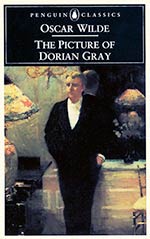
![]() Sable Aradia
Sable Aradia
1/11/2016
![]()
The incomparable Oscar Wilde is a legend in and of himself. The Picture of Dorian Gray is considered to be one of the finest horror novels of all time; and for good reason.
The plot is famous: a painter (Basil Hallward) paints a painting of an irresistible young man named Dorian Gray. Because of his fascination with Dorian and Dorian's beauty (which later generations have read, correctly I think, as homoerotic) Basil puts "too much of himself" into the painting. At the very moment that the painting is finished, while Basil, along with mutual friend Lord Henry Wotton, are admiring the work and Dorian's beauty, the combination of elements in the conversation causes Dorian to make a wish; that he should remain young and beautiful, unmarred in his appearance by time or by his sins. And a dark force grants his wish by projecting those things onto the image in the painting as time goes by. Initially embarrassed by the depth of his fascination, Basil claims he will never exhibit the painting and gives it to Dorian.
The novel now focuses on the juxtaposition between positive and negative influencing forces. Basil, a generally benevolent artist of a shy and retiring nature, represents Dorian's conscience, blissfully unaware that Lord Henry, a cynical, materialistic aristocrat with all the jaded tastes that implies and no real moral compass to guide him, exercises a corrupting influence by encouraging Dorian to explore his passions with little heed for the consequences.
The novel explores the Victorian philosophy of aestheticism; in the absence of a culturally-enforced belief in God, other philosophical and ethical avenues were being explored, one of which was the belief that beauty was sacred for its own sake. Wilde, in his clever and insightful manner, both argues for this philosophy and plainly displays its shadow side, as Dorian becomes more and more corrupt. It begins when he treats the object of a sudden love affair cruelly enough that she takes her own life, worsened by the fact that Lord Henry encourages him to be cold about it because he's enjoying the influence he has on young Dorian. This is the first sign of sin transferred to the painting, resulting in a hard and cruel caste to the image's mouth; and it subsequently sets the stage for the rest of the book as Dorian desperately tries to protect his painting -- and the secret and shame of his sins -- from discovery, with terrible results as, troubled perhaps by subconscious guilt and a wish to self-destruct over the death of his love, Dorian descends further and further into depravity.
Oscar Wilde's legendary wit shines through this dark tale all the while. Some of his most quoted lines come from this book, most of which are amazing. One is a cruel remark about women lacking substance, which is often quoted to show Wilde as a misogynist. I don't know that it proves anything; it came from the morally-corrupt Lord Henry, who at best must be viewed as an unreliable narrator. I have said it many times and I'll say it again; writers cannot be assumed to have the opinions of their characters, especially when one is quoting the villains of the piece. They're villains for a reason. Which is of interest, because it is a cruel injustice that this novel was used as evidence against Wilde in his sodomy trial (which was illegal at that time). It was offered to show Wilde as a morally corrupt effete. This, of course, would be interpreted by modern readers as LGBTQ persecution; which it was.
I understand that as to the novel being autobiographical, Wilde once said that Basil was how he saw himself; Lord Henry how the world saw him; and Dorian Gray as whom he'd like to be. This unsettles people because Dorian is not a nice person by the end of the book. But I find him sympathetic anyway. He has many admirable qualities that, in a different time and place, would have been assets rather than flaws. Perhaps Wilde was arguing for that himself.
Like most Victorian novels, this one is laden with colourful prose, which some like for its rich description and others find tedious. Certainly no modern editor would put up with it. But I love it. Everyone should read this novel at least once.